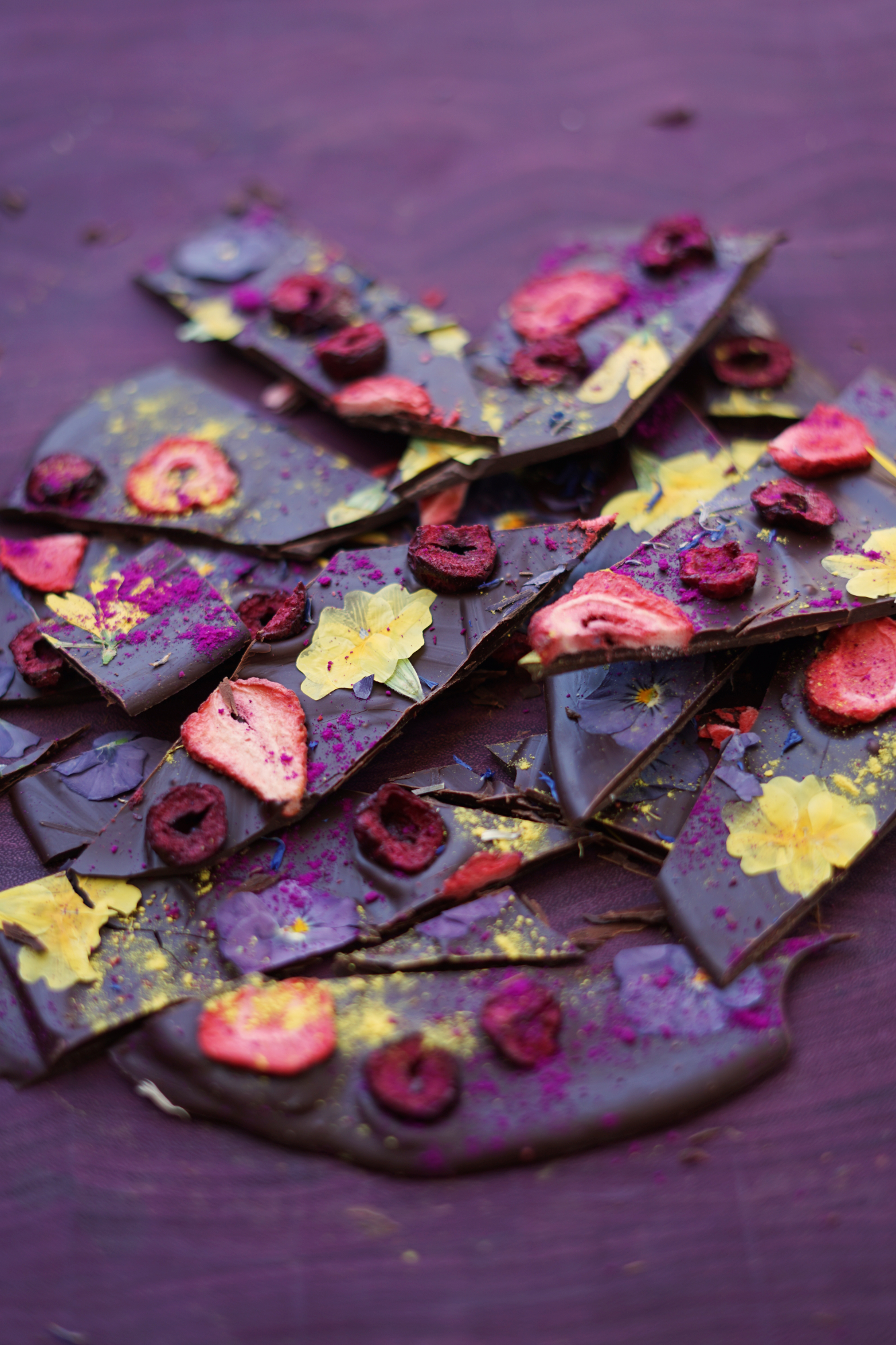Foraging For the Joy of it: Wildflower Chocolate Bark
Despite being invited to be on the reality TV show “Naked and Afraid” several times (that’s a story for another day), my interest in wild plants does not come from a desire to thrive in survival situations. And despite my interest in plants and their properties, I never set out to become an herbalist. Instead, I approach the foraging for wild plants I do out of a reverence for nature, a desire to develop an ever-deepening friendship with the landscape that holds and supports me. I forage not for survival, not for herbalism, not for purity, but for joy. That’s why you’ll still see exotic ingredients or lavish desserts or special techniques in my writing, because life is too short to deny yourself what makes you happiest, and unlocking the ancient secrets in plants is what makes my soul feel alive.
When I meet someone with a similar passion, I feel a connection, a sense of respect. That’s why I was so honored when Jay sent me chocolate from his artisanal chocolate company, The Latest Batch. (Also worth noting: we didn’t have any kind of agreement about me sponsoring the company as a trade for his gift; he just sent it because he wanted to share something he is proud of with someone he thought might appreciate it, and he was right. I’m impressed!) It’s clear to me that Jay has the same love for his cacao trees in their environment in Costa Rica as I have for the wild botanicals I gather here in the Pacific Northwest. I particularly love the ethos behind The Latest Batch: that every batch will be a little bit different, because that’s how things *work* in nature. The chocolate industry and big producers put out consistent chocolate, but sacrifice the depth of flavor that comes from working in partnership with the cacao. A hershey’s bar will always taste like a hershey’s bar, but is that really inspiring?
Instead, I love to look to these small producers to find chocolates that carry a direct message from their home, a terroir that is unique to every batch. After all, it’s the same with wild plants here as well! No two fir trees have needles that taste the same. Herbs can taste drastically different depending on geography and growing conditions. (The yarrow I find in the mountains is intensely bitter, while the yarrow from the coastal rainforests is mild and minty.) I think there is such beauty in highlighting the flavor of a specific moment in time, and my pantry of foraged goods is full of good memories of the adventures I went on to gather them. A sniff of last year’s rose petals reminds me of an afternoon in the sunlight with a good friend, while when I open a jar of dried chanterelle mushrooms I’m right back in those soggy rainforests feeling the gentle patter of raindrops on my coat.
Artisan chocolate carries with it the same beautiful associations. While I don’t have a personal connection to the cacao trees it’s sourced from, I know the maker does. That intention carries through and transports me to the wonders of another environment full of a different kind of magic. And man oh man is good chocolate magical.
Even its name, Theobroma cacao, means “food of the gods.” Sometime around 15000 B.C.E. it was cultivated by the Maya peoples of Central America, who viewed it as sacred. Cacao beans were used as currency and imbibed by kings (Montezuma was rumored to have fifty goblets of it a day!) Cacao had its place in the rituals of the day as well and found its way into marriage ceremonies, burial rites, and sacrifices to the gods. After the arrival of Cortez and his Spanish fleet of ships, cacao was introduced to Spain and slowly spread throughout Europe. Chocolate gained a faithful following everywhere it spread and has come to represent decadence, romance, passion, and reward.
When you have chocolate that is this good in your hands, you don’t want to bury it in a baked good or compete with the flavor with spices. This chocolate is pure pleasure, and I wanted to use it in a way that showed pure joy: in the process of foraging, in the artwork of decorating, and in the eating of delectable artisan chocolate.
So I looked to that same wild foods pantry that contains so many of my favorite memories, and I started pulling things out. Rose petals from that place by the river I jumped in. Cattail pollen from that hilarious date in a swamp. Pressed forsythia from that wonderful walk in early spring. To these treasured memories I added a few purchased goodies too, like freeze-dried strawberries and sour cherries. Yum.
Foraged Treasures Chocolate Bark:
Ingredients:
9 oz good quality dark chocolate
Toppings of choice
Cookie sheet lined with a silicone baking mat
Candy thermometer
Directions:
First: set the scene. Put on some of your favorite music and start looking through your pantry for goodies to add to your own chocolate bark. Seeds, nuts, dried flowers or herbs, freeze-dried fruits, dried berries… all are good candidates! You’ll want to have everything you’re using out in front of you and ready to go.
Next, you need to temper your chocolate. Tempering chocolate allows the molecules to line up in a structured pattern, giving chocolate its crisp snap and glossy finish. (Un-tempered chocolate may be crumbly or sticky, look dull, or even have a strange dotted pattern. This chocolate is not ruined - it just needs to be re-tempered.) This process takes a bit of time and patience, so keep that music playing and relax into it.
Finely chop your chocolate and place ⅔ of it in a double boiler (or a metal bowl set over a saucepan of gently boiling water, making sure the bottom of the bowl doesn’t touch the top of the water.) Gently stir the chocolate as it melts. Stick a candy thermometer in the mixture and make sure you don’t go over 120F. Once the chocolate is melted, remove the bowl from the heat. Gently wipe off the outside to remove condensation. Be very careful not to get any water into your chocolate, as it will cause it to seize and ruin it!
Stir in the remaining chopped chocolate a little at a time, stirring constantly. Keep the thermometer in the bowl and stir often until the chocolate is cooled to 82F.
Place the bowl back over the simmering water and keep stirring. Reheat until it’s just reached 88F-91F (no higher!) Remove the bowl from the heat.
Test the temper by spreading a small spoonful of the chocolate on a piece of waxed paper. If it looks dull or streaky, you’ll need to re-temper the chocolate until you get a sample that cools quickly and has a nice glossy, streak-free finish.
Pour the chocolate onto the silicone baking mat and spread out with a rubber spatula to be an even ¼” thickness.
Now you can begin decorating! Place your toppings on top of the bark however you want. When you’re finished, let the chocolate harden completely at room temperature. Once it’s completely cooled, you can cut or break it into pieces and enjoy! If you want to make your chocolate tasting extra special, try out these tips for a sensual and deep experience.
P.S. Isn't that cutting board the bread is sitting on gorgeous! I recently discovered the local artist Pisces Woodworks and asked if he'd make a custom cutting board for me purely out of purple heart wood. (It was a gift to myself for surviving my recent surgery.) He was wonderful to work with and I couldn't be happier with how it turned out! You can see more of his work on his Facebook page if you are interested.
Love what you’ve read here? Don’t forget to Subscribe to get frequent updates of new posts!
Huge thanks to my Patrons that make sharing all of these lovely posts with you possible (without all of the pop-ups and ads that make browsing other blogs so annoying). If you’re feeling generous, you too can support the wonder with a monthly contribution of your choice. Even $1 helps a lot! Your donation will help to fund this blog as well as my surprise free events and gifts for strangers. Learn more about this program at the link below:
*New to foraging and don’t know where to start? Check out this blog post on Foraging 101!





















Join me for a little winter night magic as we bake this cake full of rich seasonal flavors and black cocoa!